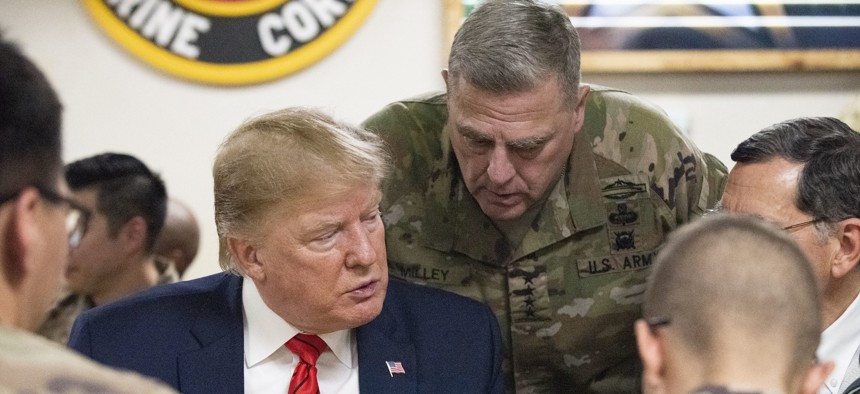
President Donald Trump and Gen. Mark Milley, chairman of the Joint Chiefs of Staff, meet with service members at Bagram Airfield in Afghanistan, Nov. 28, 2019. DOD photo by U.S. Navy Petty Officer 1st Class Dominique A. Pineiro
Why Trump and Biden Can’t Cut Troops in Afghanistan Much More
Even ‘bare minimum’ counterterrorism forces require critical intelligence only U.S. personnel can provide, officials warn.
2020 Democratic presidential front-runner Joe Biden — and possibly President Trump — want to cut the U.S. presence in Afghanistan down to the bare minimum needed to do counterterrorism strikes on al Qaeda and ISIS.
There’s just one problem: officials say the “bare minimum” isn’t much smaller than the 13,000-troop force deployed there, because a critical number of personnel are required for the intelligence gathering needed for counterterrorism missions.
The proposals come as both Trump and candidates across the Democratic field are vowing to end America’s so-called “forever wars” in the Middle East, and an inspector general report made public last week has thrust the Afghanistan conflict back into the headlines, drawing fresh scrutiny on the handling — and the cost — of the war.
“Rebuilding that country as a whole nation is beyond our capacity,” Biden said during Thursday night’s Democratic candidates’ debate. “I argued from the very beginning that we should have a policy that was based on an antiterrorism policy with a very small footprint that, in fact, only had special [operations] forces to deal with potential threats from that territory to the United States of America.”
The former vice president promised to bring “all combat troops home” from Afghanistan, leaving behind only “small numbers” of elite forces.
Trump, meanwhile, is poised to announce a drawdown of 3,000 to 4,000 troops, according to news reports. (Defense Secretary Mark Esper has declined to answer questions about the plan, saying that a decision has not yet been made.)
Former Pentagon officials argue that proposals to “end the war in Afghanistan” by pulling large numbers of regular “combat troops” and leaving special operations forces are at best reductive — and at worst deeply misleading. Even limited counterterrorism operations across a country as vast and unstable as Afghanistan, multiple former officials said, require a relatively significant number of enabling troops (and civilian and contractor personnel.) Most officials peg that minimum troop number at around 8,000 to 9,000 — the level Trump is considering. Esper said in October that the United States could decrease to 8,600 troops without affecting counterterrorism operations.
“Media should not let candidates use fuzzy math that commits to ending endless wars while continuing them,” tweeted Loren DeJonge Schulman, a former Obama administration Pentagon and National Security Council official who is deputy director of studies and senior fellow at the Center for a New American Security. “Don’t let ‘noncombat troops’ or ‘special operations teams’ become an easy mask for what they are: still war.
“If candidates want to support that option, fine! But be honest.”
Going Dark
The United States very quickly would lose the kind of intelligence it needs to carry out counterterrorism strikes, or prevent another 9/11-style attack on the homeland, if troops levels drop below 8,000, former officials say.
“All of a sudden you’re not there to collect,” said Nick Rasmussen, former director of the National Counterterrorism Center under Obama and now acting executive director of the McCain Institute. “Key decisions all along included detailed conversations about what the DOD presence enables the intelligence community to be able to do.”
Trump, who has quietly reduced the U.S. presence by roughly 1,000 troops in recent months, has claimed to be drawing down “substantially” in Afghanistan, but also acknowledged ongoing intelligence needs in the war-torn country.
“We’re going to keep a presence there,” he said in August, shortly before he ended ongoing peace negotiations with the Taliban. “We’re reducing that presence very substantially, and we’re going to always have a presence. We’re going to have high intelligence.”
Former acting CIA director Michael Morell said the United States can afford to cut some troops without losing intelligence-gathering capabilities. But if DOD shutters operating locations, then parts of the country will start to “go dark,” he said. And once lost, it can take a long time to rebuild those capabilities.
“Most people don’t understand that you can’t just turn intelligence on and turn it off,” Morell said. “Collecting intelligence and doing it well is a long term process. The best example of that is recruiting a human being. You don’t just go out and say, ‘I want to recruit a human being tomorrow with access to xyz.’” Meanwhile, “technical intelligence takes a long time for other reasons I can’t really talk about.”
That in part was why Biden wasn’t successful in influencing the Obama administration not to “surge” troops, former officials say. Biden pushed to refocus the United States on counterterrorism and away from costly efforts to train troops and help rebuild Afghan civil society. “I argued about it constantly,” he said Thursday night. “I said there was no comprehensive policy available. And then I got in a big fight for a long time with the Pentagon because I strongly opposed the nation-building notion we set about.”
Morell recalled that Biden “had a different view about what we should be doing in Afghanistan,” in an interview with Defense One prior to the debate. “His view was, ‘Let’s focus on the issue that really matters, Afghanistan being used as a base to attack the United States. Let’s not worry as much about turning Afghanistan into a functioning democracy.”
But that argument “sometimes drew opposition from the military and the [intelligence community] because it didn’t account for the enabling capacity that a larger military provided for the intelligence side of things,” Rasmussen said.
“The thing the IC folks always said to us was, ‘However long you think it takes to build those capabilities back up after you’ve dismantled them, think longer.’”
Jason Campbell, who until last year served as Trump’s director for Afghanistan at the Pentagon’s policy shop, argued that reduced U.S. intelligence-gathering in Afghanistan would force American troops to rely more heavily on its Afghan partners, who can’t do the job nearly as well. “If they’re no longer there doing that, how do you fill those gaps? Yes, we’ve been training the Afghans to do intelligence, but we’re talking about very basic ISR and HUMINT (human intelligence). Their capabilities compared to U.S. capabilities aren’t even on the same level.”
And even if the United States has the information it needs to carry out a given counterterrorism strike, “it has to be coupled with an ability to target those that are deemed a threat,” he said.
‘A Safe Haven’
For others, the entire premise of Biden’s proposal is flawed. Senior military and policymakers have insisted that the full scale of the 18-year war in Afghanistan has been necessary to prevent another 9/11. Former diplomats and Pentagon officials have warned that leaving Afghanistan without a lasting peace in place would undercut any gains in security that the United States has made since the 2001 invasion. A precipitous exit would mean a “return to civil war, leaving space for al-Qaeda and IS to grow,” wrote nine former senior U.S. diplomats this summer.
But conflating a terror group’s relative sanctuary in Afghanistan with its ability to conduct international attacks is a myth that the data does not support, some noninterventionists say.
Not only were the Sept. 11 attacks planned substantially from Germany, says the CATO Institute’s John Glaser, most of the major Islamist fundamentalist attacks on western targets since then — Madrid in 2004, London in 2005, Paris in 2015, and Brussels and Istanbul in 2016 — were similarly planned and coordinated from western locations, not “safe havens” in South Asia or the Middle East. And data suggests that the vast majority of terror attacks in the U.S. homeland since 9/11 has come from Americans themselves, either Islamist-inspired attackers radicalized over the internet or “domestic terrorism” associated with right-wing politics. According to a study from the conservative Heritage Foundation, Americans were responsible for 50 percent of the plots and attacks against the United States between 2001 and 2013, followed by UK citizens, at 21 percent.
“My sense is that the policymakers in Washington and even the practitioners have almost no ability to properly assess risk,” Glaser said. “Terrorism is not a war to be won. It’s a minor and manageable threat.”
“Statistically speaking, you’re more likely to be drowned in your own bathtub.” Even at the time, he says, the 9/11 attack was an “outlier.”
Since 2001, 2,400 U.S. troops have died in Afghanistan. A report by the Special Inspector General for Afghanistan Reconstruction, or SIGAR, made public by the Washington Post last week showed officials across administrations presented a much rosier public assessment of the conflict than was evident on the ground.
Obtained through a Freedom of Information Act request and subsequent court battle, the Post reported that the study found that U.S. officials repeatedly and emphatically acknowledged a lack of understanding of both the strategy and status of the war. Government interviewers spoke to more than 400 officials who played a direct role in the war who offered blunt retrospectives, believing that their assessments would remain confidential.
“We were devoid of a fundamental understanding of Afghanistan — we didn’t know what we were doing,” Douglas Lute, retired three-star Army general and the White House’s Afghan war czar during both the Bush and Obama administrations, said in 2015. “What are we trying to do here? We didn’t have the foggiest notion of what we were undertaking.”
Joint Chiefs Chairman Gen. Mark Milley on Friday defended the conflict. He insisted that it had achieved its central aim of preventing another devastating attack on the United States. U.S. soldiers had not “died in vain,” he said.
“None of us want forever wars, mostly those of us who serve in wars and who have taken care of our wounded and buried our dead,” he said.







